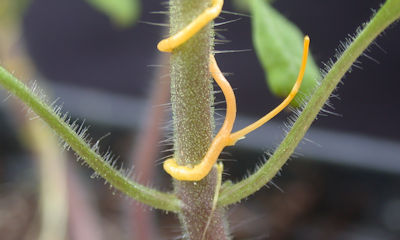August 18, 2016

The life of a plant is more complicated than many originally thought, as researchers delve into a range of factors that can influence growth and development. Scientists at the Weed Science Society of America notes that plants can sense and communicate in ways that may surprise you.
Originally, it was thought that plants were relatively simple organisms, but they are constantly changing as they sense and respond to their surroundings. WSSA Fellow Clarence Swantan, a University of Guelph researcher has made a range of findings about plants and what they seem to sense.

BEATING WEEDS: Dodder - or vampire plant - connects to host plants and shares information through RNA, researchers think breaking that communication chain could help beat the yield-robbing weed. It's new research into a promising area for weed control. (Photo: Jim Westwood, Virginia Tech)
For example, he found that corn seeds can detect whether weeds are growing above ground. They sense light reflected by weeds that penetrate the soil surface. If those corn seeds sense weeds are nearby, cellular changes are triggered that delay germination – which can result in yield losses.
He believes it may be possible to find a way to protect seeds from stresses they experience when they detect growing weeds, noting that "with the right treatment, we might be able to trigger a beneficial reaction and actually boost the development and emergence of new seedlings."
Previously, Swanton had discovered that light reflected by weeds also helps emerged corn and soybean plants sense when competitors are growing nearby. Crops respond to chemical changes that stunt both their root system and their above-ground growth. This shows that early weed control is critical so "crops are free of competitors during the earliest stages of their growth," Swanton says. "Delays can be costly. Weeds aren't just competing for water and nutrients. They actually are triggering genetic-level changes that impact crop yields."
There's interesting research on this topic in another area. At Virginia Tech, Jim Westwood is leading a research team that has studied the relationship between parasitic weed dodder – also called the "vampire plant" – and two plant "victims." One is the researcher's favorite model plant – Arabidopsis – while the other is dodder's more common prey, the tomato.
Researches already knew that dodder can sense chemical signals given off by potential host plants and uses that information to grow towards them. But once dodder attaches itself to the host plant, messenger RNAs are exchanged between the plants and serve as unique language that lets dodder and its host "chat" freely and potentially share large amounts of genetic information at the molecular level.
Westwood is working to find out what kind of information the plants share in that "relationship." He suspects that dodder may have a dastardly intent. The weeds is likely telling host plants how to lower their defenses so they can be more readily attacked, as well as how to produce more of the nutrients dodder needs to survive.
If Westwood is right, disrupting that RNA messenger sharing might protect the host plant and force dodder to wither away. Explains Westwood: "Parasitic plants can have a devastating impact on crops and are extremely hard to control. Dodder seeds, for example, can survive in the soil for decades. We hope our research will lead to innovative new strategies that will one day give growers – and their crops – the upperhand."
Source: Weed Science Society of America
You May Also Like




